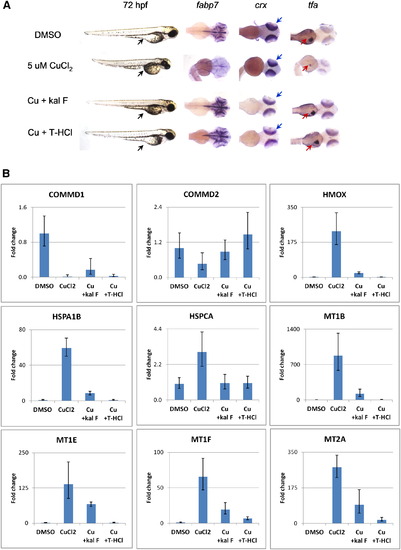Fig. 6
- ID
- ZDB-FIG-130912-30
- Publication
- Sandoval et al., 2013 - Juxtaposition of chemical and mutation-induced developmental defects in zebrafish reveal a copper-chelating activity for kalihinol f
- Other Figures
- All Figure Page
- Back to All Figure Page
|
Kalihinol F Reverses Adverse Effects of Copper Toxicity (A) Five hr postfertilization embryos were treated with 5 µM CuCl2 and rescued at 7 hpf with either 5 μg/ml kalihinol F or 10 μM T-HCl. Excessive copper resulted in a smaller embryo with pinched yolk extension (lane 1, black arrow), small head (lane 2) and eyes (lane 3), and impaired liver development (lane 4). In situ hybridization for fabp7, crx (blue arrow), and tfa (red arrow) revealed normal head development, eye size and proper liver formation, respectively, for embryos rescued with kalihinol F or T-HCl. (B) Human HepG2 cells were treated with 80 μM copper and rescued with either 30 μg/ml kalihinol F or 160 μM T-HCl. Quantitative RT-PCR showed gene expression changes induced by copper were reversed by either kalihinol F (Cu + kal F) or T-HCl (Cu + T-HCl). Graph shown above is representative of at least two experiments. Values represent mean ± SD. See also Figure S2 and Table S3. |

